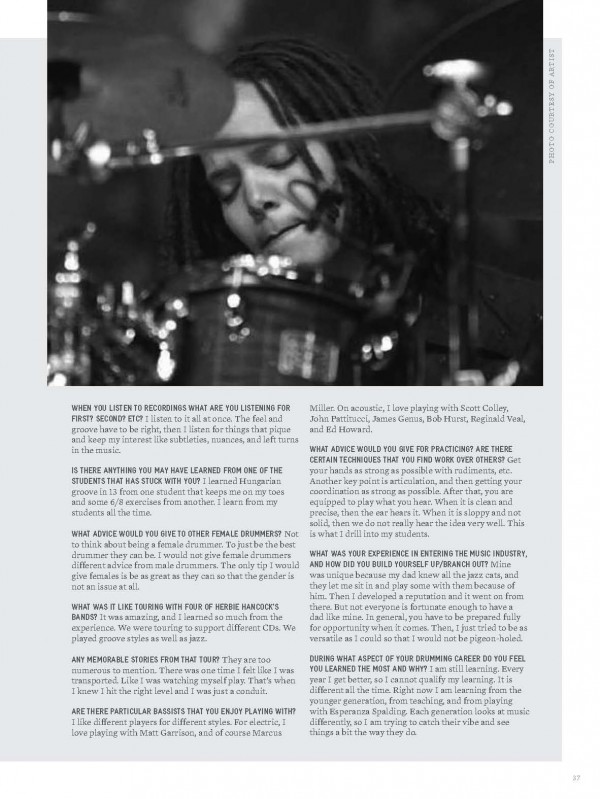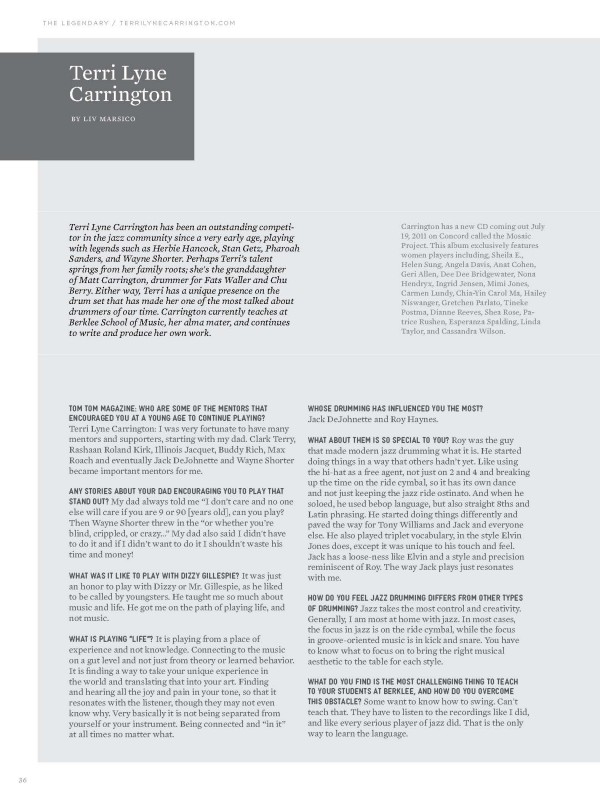Terri Lyne Carrington has been an outstanding competitor in the jazz community since a very young age, playing with legends such as Herbie Hancock, Stan Getz, Pharoah Sanders, and Wayne Shorter. Perhaps Terri’s talent springs from her family roots, being the grand daughter of Matt Carrington, drummer for Fats Waller and Chuck Berry. Either way Terri has a unique presence on the drum set that has made her one of the most talked about drummers of our time. Carrington currently teaches at Berklee School of Music, her alma mater, and continues to write and produce her own work.
-By Liv Marsico
Tom Tom Magazine: Who are some of the mentors that encouraged you at a young age to continue playing?
Terri Lyne Carrington: I was very fortunate to have many mentors and supporters, starting with my Dad. Clark Terry, Rashaan Roland Kirk, Illinois Jacquet, Buddy Rich, Max Roach and eventually Jack DeJohnette and Wayne Shorter became important mentors for me.
TTM: Any stories about your Dad encouraging you to play that stand out?
TLC: My dad always told me “I don’t care and no one else will care if you are 9 or 90 [years old], can you play? Then Wayne Shorter threw in the or whether you’re blind crippled or crazy….” ☺ My Dad also said I did not have to do it and if I didn’t want to maybe I could not waste his time and money!
TTM: What was it like to play with Dizzy Gillespie?
TLC: It was just an honor to play with Dizzy or Mr. Gillespie, as he liked to be called by youngsters. He taught me so much about music and life. He got me on the path of playing life, and not music.
TTM: What is playing “life”?
TLC: It is playing from a place of experience and not knowledge. Connecting to the music on a gut level and not just from theory or learned behavior. It is finding a way to take your unique experience in the world and translating that into your art. Finding and hearing all the joy and pain in your tone, so that it resonates with the listener, though they may not even know why. Very basically, it is not being separated from yourself or your instrument. Being connected and “in it” at all times no matter what.
TTM: Who’s drumming do you think has influenced you the most?
TLC: Jack DeJohnette and Roy Haynes.
TTM: What about them is so special to you?
TLC: Roy was the guy that made modern jazz drumming what it is because he started doing things in a way that others hadn’t yet, like using the hi hat as a free agent, not just on 2 and 4 and breaking up the time on the ride cymbal, so it has it’s own dance and not just keeping the jazz ride ostinato. And when he solos he used be bop language but also straight 8ths and phrasing that may seem Latin. He just started doing things differently and paved the way for Tony Williams and Jack and everyone else. He also played triplet vocabulary, in the style Elvin Jones does, but it sounded different because his touch and feel are different. Jack has a loose-ness like Elvin and a touch and precision reminiscent of Roy. The way Jack plays just resonates with me.
TTM: How do you feel jazz drumming differs from other types of drumming?
TLC: Jazz takes the most control and creativity. Generally, I am most at home with jazz. In most cases, the focus in jazz is on the ride cymbal. The focus in groove-oriented music is in kick and snare. You have to know what to focus on to bring the right musical aesthetic to the table for each style.
TTM: What do you find is the most challenging thing to teach to your students at Berklee, and how do you overcome this obstacle?
TLC: Some want to know how to swing. Can’t teach that. They have to listen to the recordings like I did, and like every serious player of jazz did. That is the only way to learn the language.
TTM: When you listen to recordings what are you listening for first? Second? Etc?
TLC: I listen to it all at once. Maybe feel and groove have to be right, then I listen for things that peek and keep my interest, subtleties and nuances and left turns in the music.
TTM: Is there anything you may have learned from one of the students that has stuck with you?
TLC: I learned Hungarian groove in 13 from one student that keeps me on my toes and some 6/8 exercises from another. I learn from my students all the time.
TTM: What advice would you give to other female drummers?
TLC: Not to think about being a female drummer. To just be the best drummer they can be. I would not give female drummers different advice from male drummers. The only tip I would give females is be as great as they can so that the gender is not an issue at all.
TTM: What was it like touring with four of Herbie Hancock’s band?
TLC: It was amazing, and I learned so much from the experience. We were touring to support different cd’s. We played groove styles as well as jazz.
TTM: What was your experience in entering the music industry, and how did you build yourself up/branch out?
TLC: Mine was unique because my Dad knew all the jazz cats and they let me sit in and play some with them because of him. Then I developed a reputation and it went on from there. But not everyone is fortunate enough to have a dad like mine. In general, you have to be prepared fully for opportunity when it comes. Then, I just tried to be as versatile as I could so that I would not be pigeon holed.
TTM: During what aspect of your drumming career do you feel you learned the most and why?
TLC: I am still learning. Every year I get better, so I cannot qualify my learning. It is different all the time. Right now I am learning from the younger generation from teaching and from playing with Esperanza Spalding. Each generation looks at music differently, so I am trying to catch their vibe and see things a bit the way they do.
Terri has a new CD out as of July 19, 2011 on Concord called the Mosaic Project, featuring all women cast including Sheila E., Helen Sung, Angela Davis, Anat Cohen and more. The Mosaic Project consist of some of the finest female instrumentalists and vocalists in the world, ‘women with voices,’ coming together to support and celebrate each other from a musical and social perspective. The CD comments on historical, current and appropriately feminine themes with the intent to offer an informative, enjoyable, listening experience, driven by creativity and consciousness. As with mosaic art work, the goal for this project is to vibrantly connect colorful pieces together to create something integral, using thoroughly composed song forms, some abstract improvising, and also the human voice – to create ‘sharp shapes, with blurred edges.’ The Mosaic Project is cross generational, cross cultural and though ‘jazz’ in nature, somewhat ‘cross genre,’ which is pertinent because jazz has increasingly pollinated, allowing it’s language to metamorphose into something
one group of musicians alone cannot claim.
Subscribe to Tom Tom Magazine to see the full interview with her in print.



